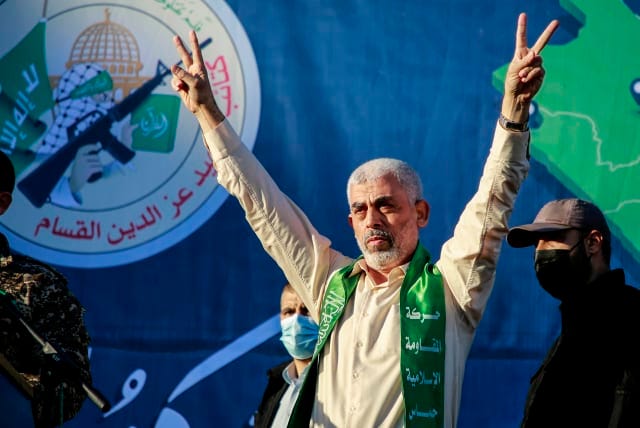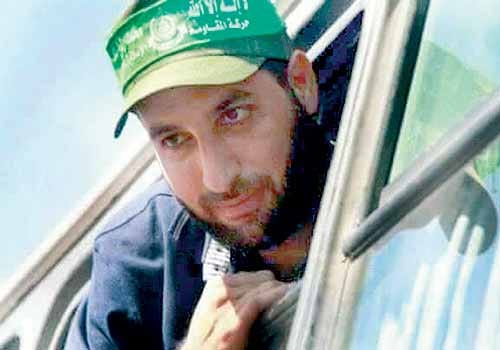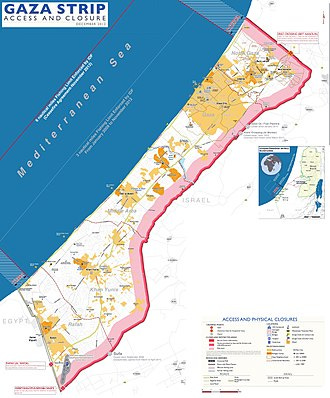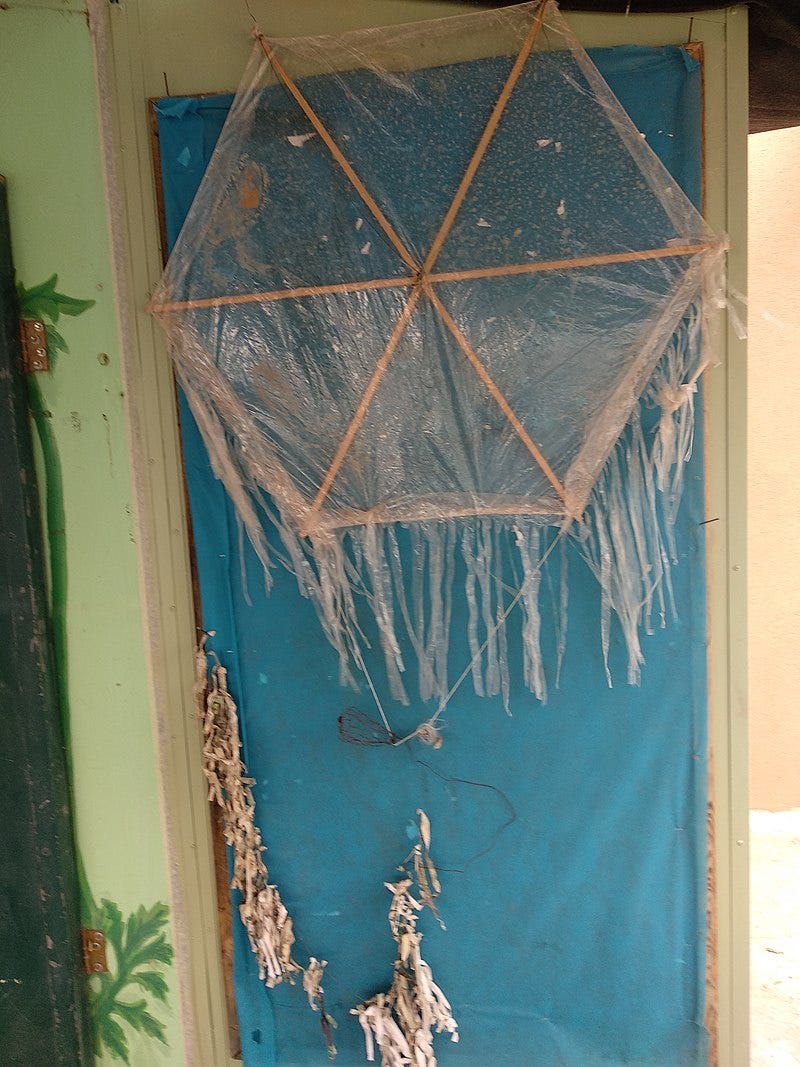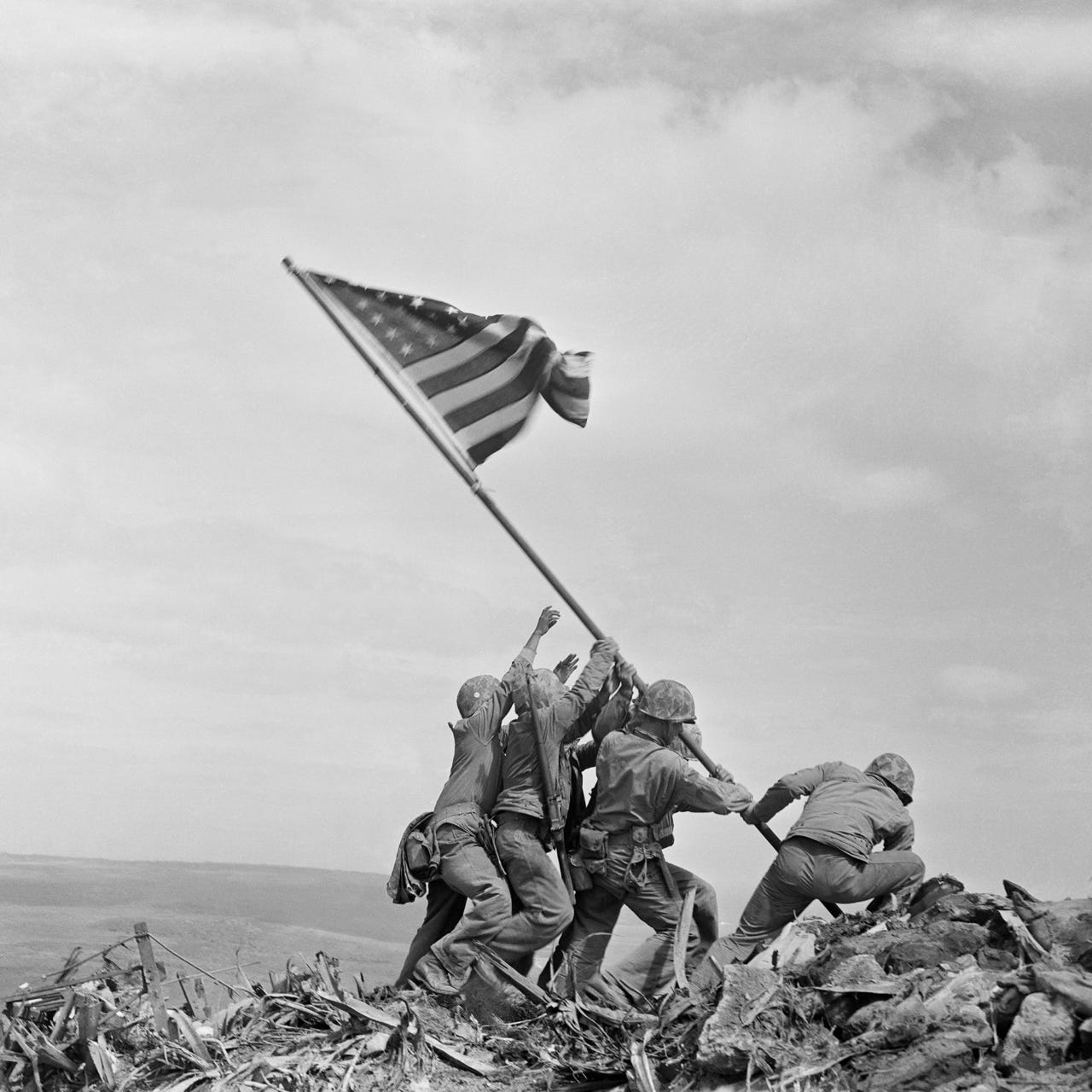In my last post I cover 2015-2016, and the Hidden Intifada. Today I will cover 2017 to 2019 and the Great March of Return.
2017
In January 2017, there were three stabbings or attempted stabbings, nine shootings, two ramming attacks, nine roadside bombs or grenades attacks, 293 stone-throwing attacks, and 44 Molotov cocktail attacks. Five Israelis were killed and 21 were wounded.
In February there was one stabbing or attempted stabbing, five shootings, one ramming attack, seven bomb or grenade attacks, 260 stone-throwing attacks, and 53 Molotov cocktail attacks. There were no deaths but seven Israelis were wounded.
On February 13, 2017, Yahya Sinwar the commander of the Izz ad-Din al-Qassam Brigades, was elected Prime Minister of Hamas in Gaza, during a secret election. Sinwar was elected to replace Ismail Haniyeh, who had been promoted to Chairman of Hamas in 2016.
In March there were ten stabbings or attempted stabbings, three shootings, one ramming attack, two bomb or grenade attacks, 243 stone-throwing attacks, and 62 Molotov cocktail attacks. There were no deaths but eleven Israelis were injured.
On March 24, 2017, a Hamas military leader Mazen Fuqaha was shot and killed in his car in front of his house. Hamas and the Palestinian Authority quickly blamed Israel. However, Israeli officials did not comment on his death, only stating that he had been involved in planning attacks against Israel. In 2002 an Israeli court had sentenced Fuqaha to life in prison plus 50 years for planning a suicide bombing on a bus at the Meron junction that killed nine people and wounded 38 others. Fuqaha had been released in 2011 as a part of the Gilad Schalit prisoner swap, but the conditions of his release barred him from returning to the West Bank. Fuqaha had been close friends with the newly elected Prime Minister of Hamas, Yahya Sinwar, the two had even shared an Israeli prison cell for a year.
In April there were seven stabbings or attempted stabbings, five shootings, two ramming attacks, four bomb or grenade attacks, 218 stone-throwing attacks, and 40 Molotov cocktail attacks. Two Israelis were killed and 21 were wounded.
In May there were nine stabbings or attempted stabbings, six bomb or grenade attacks, 284 stone-throwing attacks, and 63 Molotov cocktail attacks. There were no deaths but seven Israelis were injured.
On May 1, 2017, for the first time since the release of its founding Charter, Hamas published a new policy document. To read the entire document click here. The publication of the document, which slightly toned down the incendiary rhetoric and language used in their 1988 Charter, was widely viewed as a PR move to soften the image of the terrorist organization.
The main points of the new document were:
Hamas stated that Islam is the sole source of authority for its strategies and objectives.
There was a denial of a Jewish right to self-determination, and claimed that Israel’s establishment as a state was entirely illegitimate. It also depicted Zionism as the enemy of humanity. Hamas claimed it “does not wage a struggle against the Jews because they are Jewish but wages a struggle against the Zionists who occupy Palestine.”
Hamas stated a belief of an “Arab-Islamic” and “sacred Islamic” character for all of Palestine, and a complete denial of any bond or right to the land for Jews or Christians. (Hamas believes, based on the Koran and Islamic sources, Jesus was neither a Jew nor a Christian but a prophet of Islam who received the Islamic doctrine from Allah.)
They stated a justification of the armed struggle to liberate Palestine and the existence and activity of the “struggle organizations” (Hamas, PIJ, PFLP, etc.)
Hamas stated a willingness for a Palestinian state to be established within temporary borders (the June 3, 1967 lines) as a step toward continuing the armed struggle to destroy Israel, and establish a Palestinian state “from the river to the sea.”
They recognized the Palestine Liberation Organization, while also demanding new elections and denying the validity of the organization’s political line or any of the agreements it signed with Israel.
Hamas praised the “free people” in the world who support the Palestinian struggle against Israel.
A spokesman for Israeli Prime Minister Benjamin Netanyahu said that Hamas was trying to fool the world, but it would not succeed.
In June there were five stabbings or attempted stabbings, four shootings, six bomb or grenade attacks, 131 stone-throwing attacks, and 27 Molotov cocktail attacks. There were no deaths but twelve Israelis were wounded.
In July there were five stabbings or attempted stabbings; six shootings, 14 bomb or grenade attacks, two ramming attacks, 210 stone-throwing attacks, and 61 Molotov cocktail attacks. Five Israelis were killed and 23 were wounded. including the following example.
On July 14, 2017, three Arab-Israeli men left the Temple Mount, and opened fire on Israeli border police officers stationed close to the Lions’ Gate. Two Israeli border police officers were killed and two more were injured in the attack. All three attackers were shot and killed by Israeli police after fleeing back into the complex. Hamas claimed responsability for the attack.
On July 26, 2017, Judges at the European Court of Justice (ECJ), overturned a General Court ruling, which had said there was not enough evidence to keep travel bans and asset freezes on Hamas. The lower court had said in 2014, that the listing was based on media reports, not decisions by "competent authorities". The ECJ, however, said such decisions were not needed to keep groups on the list. The ECJ said decisions by the competent authorities were only required for the initial listing of groups or individuals.
In August there were three stabbings/attempted stabbings, one shooting, seven bomb or grenade attacks, 128 stone-throwing attacks, and 23 Molotov cocktail attacks. There were no deaths but four Israelis were wounded.
In September there was one stabbing/attempted stabbing, one shooting, five bomb or grenade attacks, 135 stone-throwing attacks, and 27 Molotov cocktail attacks. Three Israelis were killed and ten were injured.
In October there were three stabbing/attempted stabbings, two shootings, four bomb or grenade attacks, 170 stone-throwing attacks, and 32 Molotov cocktail attacks. One Israeli was killed and nine wounded.
In November there were two stabbing/attempted stabbings, one shooting, one bomb or grenade attacks, 207 stone-throwing attacks, and 25 Molotov cocktail attacks. Two Israelis were killed and 19 were injured.
In December 2017, there were three stabbings/attempted stabbings, three shootings, nine bomb or grenade attacks, 478 stone-throwing attacks, and 111 Molotov cocktail attacks. No Israeils were killed and six were wounded.
2018
In January 2018, there were two stabbings/attempted stabbings, two shootings, one ramming attacks, four bomb or grenade attacks, 251 stone-throwing attacks and 45 Molotov cocktail attacks. One Israeli was killed and 16 were wounded, including the incident below.
On Jaunary 9, 2018 while driving down a highway near the West Bank city of Nablus, Rabbi Raziel Shevach was shot in the neck by a passing vehicle. He managed to call his wife, who called emergency services. The Rabbi was taken to the hospital but was pronounced dead on arrival. Hamas claimed responsability for the attack.
On January 12, the US State Department announced that Ismail Haniyeh had been named a Specially Designated Global Terrorist along with other senior Hamas officials, including Mohammed Deif, chief commander of the Izz ad-Din al-Qassam Brigades, and fellow members of the political bureau Yahya Sinwar, Ruhi Mushtaha, Fathi Hamad, and Ahmed al-Ghandour. Senior Hamas figures hurried to condemn the US declaration. Haniyeh himself stated that “The Trump regime can immerse itself in the water of Gaza and drink it.” Senior Hamas official Fathi al-Karawei said that this was a “mark of Cain” on Washington’s forehead.
In February there were four stabbings/attempted stabbings, two shootings, four bomb or grenade attacks, 283 stone-throwing attacks, and 49 Molotov cocktail attacks. One Israeli was killed and seven were injured.
In March there were two stabbings/attempted stabbings, six shootings, two ramming attacks, three bomb or grenade attacks, 240 stone-throwing attacks, and 24 Molotov cocktail attacks. Three Israelis were killed and eight were wounded.
On March 7, alarmed by the growing ties between Israel and the Arab world, (the Trump-backed Abraham Accords), Hamas condemned the normalization of relations with Israel, and warned it would not forgive anyone who normalizes relations with the enemy. They also endorsed the efforts of the international BDS (Boycott, Divest and Sanction), movement, at isolating Israel.
The Great March of Return
The Great March of Return was initially planned to be a six-week non-violent protest campaign by Palestinians at the Gaza border with Israel. The end goal was to express their desire to return to “their lands”. In the weeks leading up to the protest, word of the march reached Hamas and Palestinian Islamic Jihad, who endorsed the protests, but sought to co-opt them to serve their own objectives.
The first protest took place on March 30, 2018, during Land Day (a day marking the 42nd anniversary of the annexation of 20,000 acres of land near Galilee by Israel). 30,000 Palestinians took part in the protests, based at five tent camps that were set up 600 meters from the Israel–Gaza fence. This was close to the area designated by Israel as a “no go area” which was a 300 meter strip starting at the fence.
The majority of the demonstrators in the encampments stayed away from the border area and did not engage in violence. However, hundreds of young Palestinians ignored the warnings to avoid the the border zone issued by the organizers of the protests and the IDF. When some Palestinians began throwing stones and Molotov cocktails, the IDF declared the border area a closed military zone, and after attempting to disperse the crowd with tear gas and rubber bullets, opened fire with live rounds. The events of the day were some of the most violent in recent years. In one incident, two Palestinian gunmen approached the fence, armed with AK-47s and hand grenades, and exchanged fire with IDF soldiers, both were killed. 15 Palestinians were killed by the IDF that day.
Protest organizers and Hamas called for renewed demonstrations at the border the following Friday, April 6. The IDF stated that it intended to use the same escalation of force levels as the preceding week, in order to prevent infiltrations of Israeli territory.
In April 2018, there was one stabbing/attempted stabbing, four shootings, 17 bomb or grenade attacks, 216 stone-throwing attacks, and 33 Molotov cocktail attacks. There were no deaths but three Israelis were wounded.
The protests on April 6, were dubbed the "Day of the Tire" (Israeli officials cautioned that the mass burning of tires along the border could produce environmental harm, calling on the World Health Organization to prevent, what they termed, an "ecological catastrophe"). Thousands of Palestinians joined in the demonstrations; the IDF estimated their number at 20,000. Thousands of tires were burned to obscure what the radicals were doing closer to the fense. After attempting to dispurse the crowd, as they had the previous week, live rounds were again used. Nine Palestinians were killed, and 1,350 were injured in the rioting.
April 13 was the third consecutive Friday with a protest. It was smaller than the previous weeks, with an estimated 10,000 people. Once again, Palestinians rioters attempted to breach the border fence, hurling molotov cocktails and explosive devices, and even attempted to fly kites with incendary devices attached to the tails into Israeli territory to start fires. Three rioters were killed and 25 wounded.
April 14, PIJ reported that four of their members were killed in a blast near one of the protest camps. According to the statement the terrorists died during "preparations".
On April 15, the IDF destroyed a tunnel that crossed the Gaza-Israel border.
The protests on Friday April 20, were labeled the "Women's March of Gaza" and were intended to highlight the active role women were playing in the protest. The IDF estimated that 10,000 people participated in the protest. Before the expected protests, the IDF dropped leaflets over Gaza Strip warning anyone against approaching the fence or attempting to damage it. Once again, the rioters ignored all calls from Israel for people to stay away from the fence and protest peacefully. Five Palestinians were killed and 50 were injured.
The protest on April 27, called the "Day of Rebellious Youth”, saw another 10,000 people participate. This time, however, the protesters reached the electrified border fence, having passed the smaller barbed wire barrier. Israeli soldiers fired shots and threw a hand grenade at a group of twelve men climbing the fence, killing three. A large crowd rushed toward the Karni border crossing, after a speech by Hamas leader Ismail Radwan. The IDF responded with tear gas and with live ammunition, injuring several people. Two armed Palestinians, among the large crowd, approached the border and fired at least seven rounds at Israeli soldiers, but none were hit. The Israeli response wounded two rioters.
On April 29, a “Molotov kite” launched from Gaza caused a large fire in the Be’eri Forest, burning hundreds of acres of woodlands. Ten teams of firefighters fought to contain, then extinguish the forest fire.
In May there were ten shooting attacks, two ramming attacks, 15 bomb or grenade attacks, and 251 stone-throwing attacks. There were no deaths but 17 Israelis were wounded.
The May 4 protesters were called “Friday of the Palestinian Worker," in honor of International Workers’ Day, which had occurred earlier that week. Another 10,000 people participated in the protests. Shortly after noon, the protests turned violent with people throwing stones, burning tires, and launched hundreds of Molotov kites intending to fly them in swarms into Israel exploiting a heat wave to ignite fires. However, the wind was blowing in the wrong direction and the effort failed. The IDF responded with tear gas and rubber bullets, and when that didn’t stop the rioters, live fire. Protesters also entered and damaged the Kerem Shalom border crossing, including a pipeline and fuel pump that Israel uses to supply fuel to Gaza. 82 rioters were injured.
15,000 demonstrators took part in the Friday protest on May 11. Many tires were burned, in the hope the smoke would provide cover for saboteurs to cross and destroy the border fence. They threw grenades, pipe bombs and stones at Israeli troops and as had been the norm, the IDF responded with tear gass and live fire. Molotov kites were out in force again, but this time the IDF used new, small drones with knives on their wings to counter the kites, downing 43. One Palestinian was killed and 973 were injured during the riots. The next day Israel announced that the Kerem Shalom border crossing "will remain closed until the damage caused by the riots are repaired and will only reopen in accordance with a security assessment, opening only for humanitarian cases until such a decision is made.”
On May 13, 2018, the IDF discovered and destroyed a Hamas terror tunnel that had been dug under the Mediterranean Sea. This would have allowed Hamas militants to conduct an attack and disappear silently into the sea. In response to these maritime threats, the Defense Ministry began constructing an underwater barrier in June 2018, to prevent Hamas infiltrations into Israeli coastal communities by sea. It included one barrier below sea level, a layer of armored stone, and a third layer with barbed wire.
On May 14, the 70th anniversary of the foundation of Israel, and also coinciding with the ceremony marking the relocation of the US embassy to Jerusalem, another large protest occurred, this one with at least 18,000 people in attendance. It soon turned violent with burning tires, stones and Molotov cocktails being thrown, and militants charging the border fence. Tear gas and rubber bullets were ineffective and the IDF soldiers started firing live rounds, 62 rioters were killed and 1200 were injured. This was the the bloodiest day in Gaza since the end of the 2014 war. Hamas announced that 50 of the dead were their fighters and PIJ claimed three others, meaning that the vast majority of those killed on May 14, were terrorists. This day would mark a change in the protests/riots. After bowing to pressure from Egypt Hamas to lessen the violence, there were fewer incidents and much fewer Hamas personal at the border, making for much calmer protests.
On May 18 the Friday protests were attended by over 1,200 people but are fairly quiet. A few tires were burned and a few things hurled at the fence but no one approached the border and the IDF did not have to use any crowd control methods.
On May 25, 1,600 people attended the weekly Friday protest. There was also a visit by Ismail Haniyeah and Yahya Sinwar, who whipped up the crowd, saying:
“We will take down the border and we will tear out their hearts from their bodies.”
Dozens of youth came within 300 meters of the fence, trying to breach it, burning tires and throwing explosive devices towards the soldiers on the Israeli side. More Molotov kites were flown over the border but all were shot down by the Israelis. The IDF responded to the events with the usual tear gas and rubber bullets and when they did not break up the riot, live fire. No Arabs were killed but 110 were wounded.
In June 2018, there were two shootings, one ramming attack, 14 bomb or grenade attacks, 77 Molotov cocktail attacks (includes incendiary kites/balloons), and 76 rockets launched into Israel. One Israeli was killed and 30 were wounded.
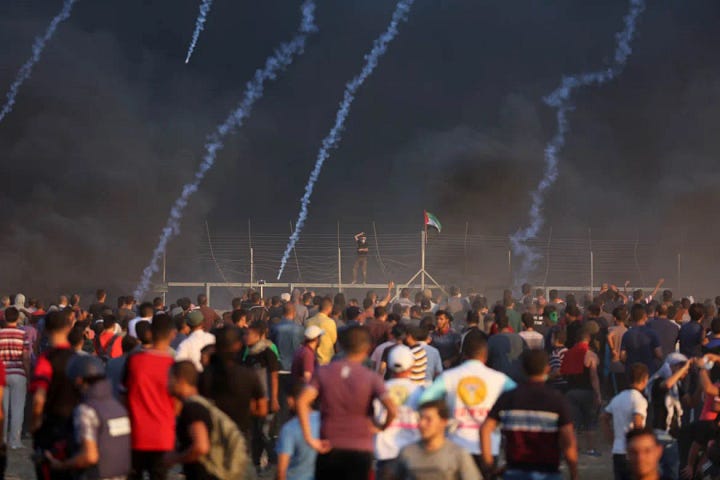
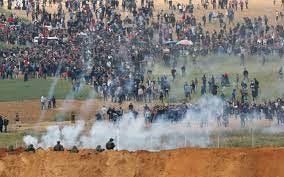
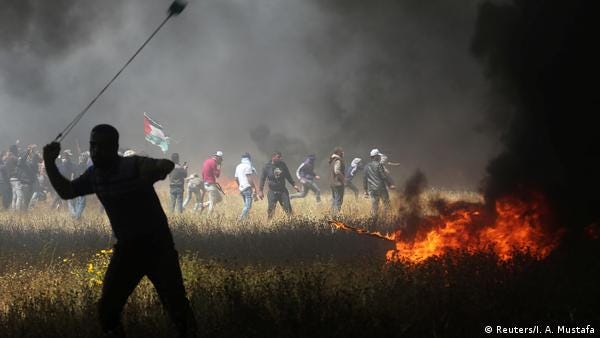
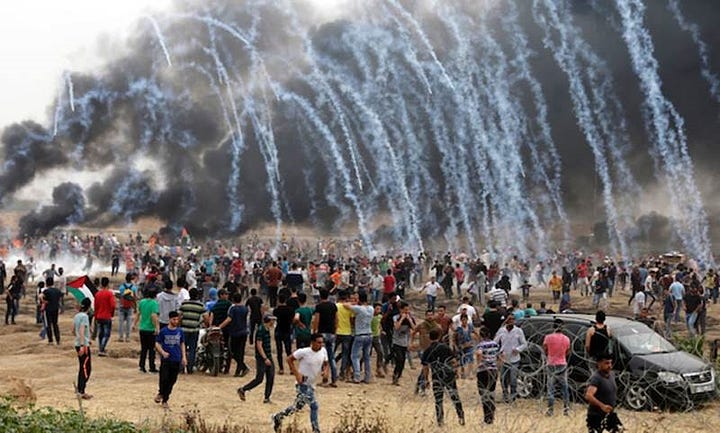
Between June 1, and August 24, there were protests every Friday. They all followed the usual pattern; Palestinians burned tires to obscur what was happening, ran up to the border fence, attempting to damage it or get past it, threw rocks explosive devices and Molotov cocktails, fired upon IDF vehicles. Many Molotov kites were flown into Israel and firefighters had to be called in to douse fires on the Israeli side of the border. Over the course of these riots 18 Arabs were killed and another 2,579 were injured, although most of these were injuries from rubber bullets and tear gas. Over the entire course of the Great March of Return, 183 Palestinians were killed and 6,106 were wounded by live fire from the IDF, another 3,098 were injured by rubber bullets or tear gas. The Israelis lost two soldiers and another 35 were wounded.
In July there was one stabbing/attempted stabbing, five shootings, nine bomb or grenade attacks, 118 stone-throwing attacks and 202 Molotov attacks (includes incendiary kites/balloons). Two Israelis were killed and 17 injured.
On July 16, Israel announced that, in response to the Molotov kites flown inot Israel, the government would temporarily suspend deliveries of gas through the Kerem Shalom border crossingand would also limit authorized areas for Arab offshore fishing to half the previous area. In response to this Hamas militants outfitted a falcon with a harness and flammable material at the end of a steel wire and sent the bird across the border. The bird started a small fire but did not survive, and the fire was quickly extinguished.
In August there was one stabbing/attempted stabbing, two shooting attacks, ten bomb or grenade attacks, 125 stone-throwing attacks and 99 Molotov attacks (includes incendiary kites/balloons). One Israeli was killed and nine were injured.
In September there were four stabbing/attempted stabbings, two shooting attacks, 17 bomb or grenade attacks, 128 stone-throwing, and 120 Molotov attacks (includes incendiary kites/balloons). One Israeli was killed and ten wounded.
In October there were four stabbing/attempted stabbing; one shooting, 19 bomb or grenade attacksl, 138 stone-throwing, and 139 Molotov attacks (includes incendiary kites/balloons). Two Israelis were killed and 18 were wounded.
In November there were four stabbing/attempted stabbing, five shootings, one ramming attack, eight bomb or grenade attacks, 178 stone-throwing attacks, and 42 Molotov attacks (includes incendiary kites/balloons). One Israeli was killed and 14 were wounded.
On November 11, a botched Israeli covert operation carried out in Khan Yunis in the southern Gaza Strip, killed seven Palestinian militants and one Israeli soldier. Exchanges of fire between the two sides lasted for two more days, until a cease fire was achieved with Egyptian mediation.
In December 2018, there were three stabbing/attempted stabbing, three shootings, four ramming attacks, eight bomb or grenade attacks, 270 stone-throwing attacks, and 30 Molotov attacks. Three Israelis were killed and 28 injured.
2019
In January there were three stabbings/attempted stabbings, four shootings, 19 bomb or grenade attacks, 145 stone-throwing attacks and 30 Molotov attacks. There were no deaths but 13 Israelis were wounded.
In February there were five stabbings/attempted stabbings, 20 bomb or grenade attacks, 129 stone-throwing attacks. One Israeli was killed and six were injured.
In March there were two stabbing/attempted stabbings, one shooting, one ramming attack, 36 bomb or grenade attacks, 126 stone-throwing events and 55 Molotov attacks. Two Israelis were killed and 24 were wounded.
In April 2018, there was one stabbing/attempted stabbings, one ramming attack, 137 stone-throwing attacks, and 23 Molotov attacks. There were no casualties.
In May there were seven stabbing/attempted stabbings, 5 shootings, three ramming attacks, 119 stone-throwing attacks and 57 Molotov attacks. Four Israelis were killed and ten were injured.
On May 3, 2019, two Israeli soldiers were injured by sniper fire from the Gaza Strip during protests at the border. In response, the Israeli Air Force (IAF) carried out an airstrike, killing two Hamas militants and wounding two more. The next day Hamas launched 250 rockets into Israel, wounding one. In response to the rocket fire, the IAF carried out 120 airstrikes in Gaza, killing two militants.
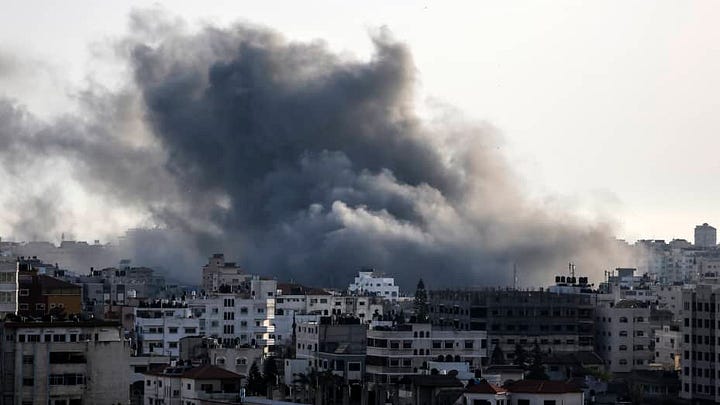
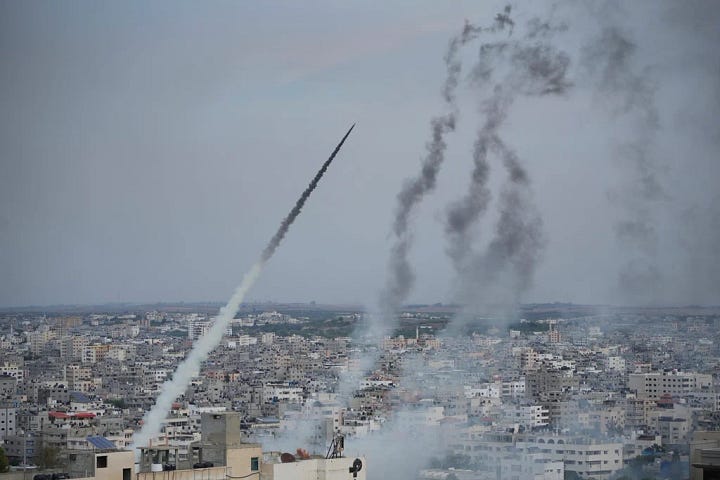
On May 5, Hamas launched 200 rockets and morters into Israel, killing four Israelis and wounding another six. In response the IAF carried out 210 airstrikes, killing two and injuring eleven. Hamas threatened to use their longer range rockets to hit deep inside Israel if the airstrikes did not stop. Because of the escalating situation the IDF moved two brigades to the border area.
On May 6, a ceasefire facilitated by Egyptian mediators went into effect.
In June there were four stabbing/attempted stabbings, one shooting, 127 stone-throwing attacks and 27 Molotov attacks. There were no casualties.
In July there were one stabbing/attempted stabbings, 143 stone-throwing attacks and 14 Molotov attacks. There were no casualties.
In August there were two stabbing/attempted stabbings, two shooting, 127 stone-throwing attacks and 46 Molotov attacks. Two Israelis were killed and eight wounded.
In September there were three stabbings/attempted stabbings, one shootings, 11 bomb or grenade attacks, 119 stone-throwing attacks and 10 Molotov attacks. No Israelis were killed but seven people were injured.
In October 2019, there was one stabbing/attempted stabbing, four shootings, 17 bomb or grenade attacks, 216 stone-throwing attacks, and 33 Molotov cocktail attacks. There were no deaths but two Israelis were were wounded.
In November there were five stabbings or attempted stabbings, four shootings, six bomb or grenade attacks, 131 stone-throwing attacks, and 27 Molotov cocktail attacks. No one was killed but eleven Israelis were injured.
Before dawn on November 12, the IAF carried out an airstrike on Baha Abu al-Ata, commander of the PIJ's northern sector of the Gaza Strip. The airstrike struck the top floor of an apartment building where he was sleeping, killing him and his wife. Two other people were injured. PIJ and Hamas responded with rocket fire into Israel, including long-range rockets fired towards Tel Aviv. According to the IDF 90% of the rockets were intercepted by the Iron Dome defense system. In response to the rocket fire, Israel carried out airstrikes and artillery shelling in the Gaza Strip, killing and wounding several militants as well as civilians. During al-Ata's funeral, senior Islamic Jihad official Khaled al-Batsh labeled the two Israeli strikes in Gaza and Syria a "declaration of war", and vowed that the group's response would "rock the Zionist entity”. Hamas stated that the killing of al-Ata would not go unpunished.
On November 13, rocket fire from Gaza resumed, with a morning barrage that reached Netivot in the south and Beit Shemesh in central Israel. Most of the rockets were intercepted by the Iron Dome system. Of course the IAF responded with airstrikes, in one of the attacks, the IAF attacked a Palestinian rocket squad, killing two and wounding two. A PIJ official stated that the group is not interested in a discussing a ceasefire with Israel at the moment and will only do so after the "message" to Israel is delivered. By the night of the 13th the number of rockets fired into Israel was over 400, 60% of which hit open fields in Israel, while the IDF said the Iron Dome defense system has had a success rate of 90% against rockets that were projected to hit populated areas.
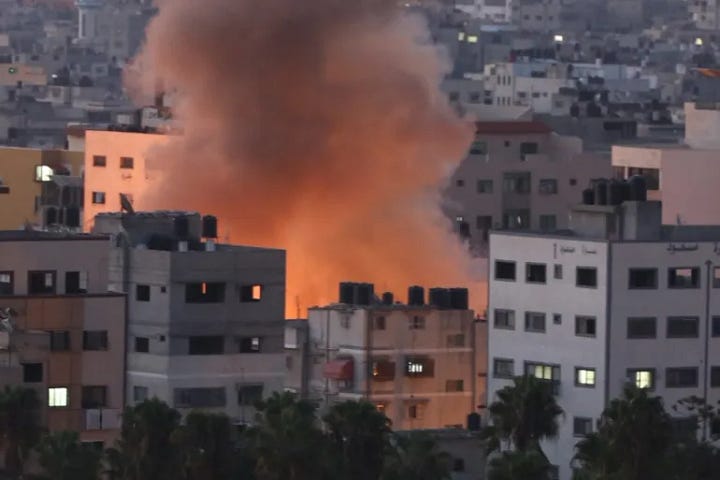
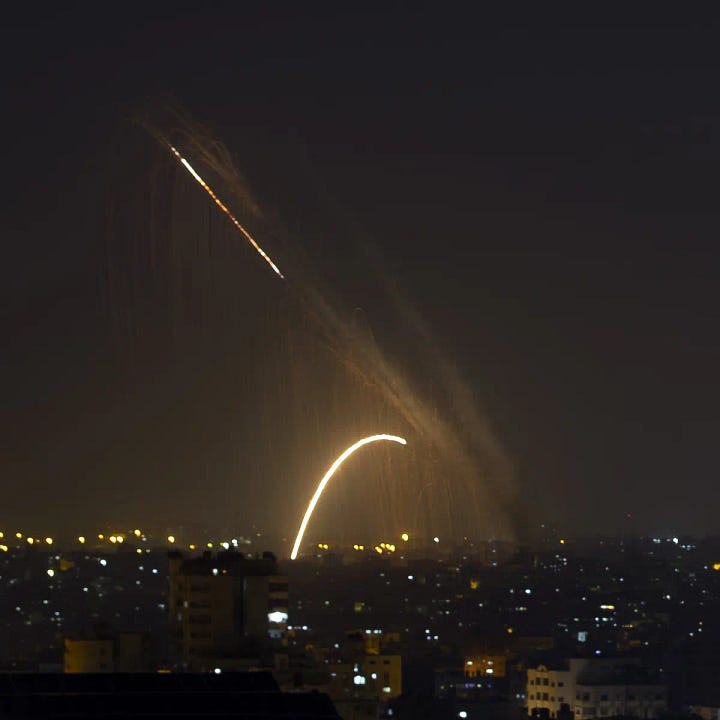
On November 14, an Egyptian brokered ceasefire went into effect.
In December 2019, there were two stabbings or attempted stabbings, one shooting, two bomb or grenade attacks, 91 stone-throwing attacks, and 12 Molotov cocktail attacks. There were no casualties.
I appolgize for the scant information on terrorist attacks in this in installment, you would think that the closer to the present we get, the more information there would be, but it seems to be the opposite. I searched high and low and all I could come up with were the monthly totals. As we have seen this period was a time of provocacation and learning for Hamas. I’m not sure if they already had plans for October 7, but if they were in the early stages of planning, then this was a good example for what Israel was going to do in response to any probing of the border area. Next week I will take a look at 2019 to October 7, 2023. As always, please share this with everyone you can and feel free to leave a comment.
Chris




